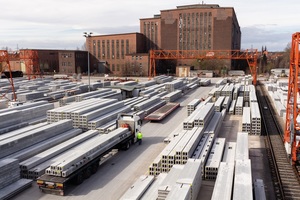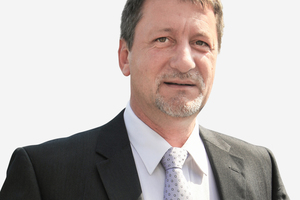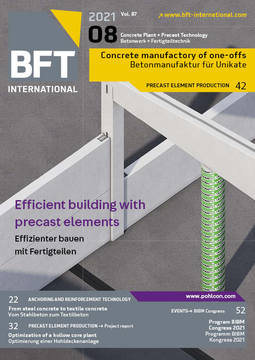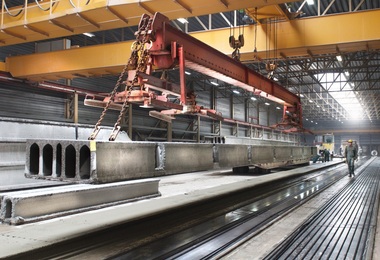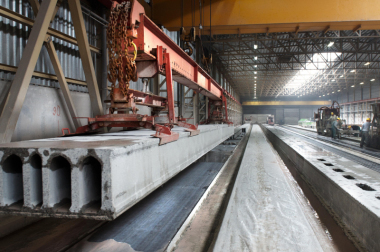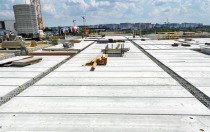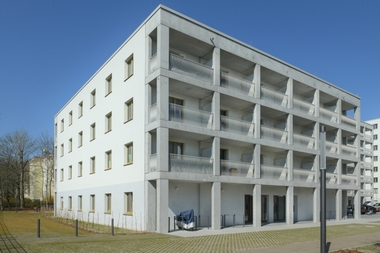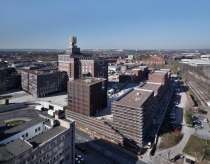Interview: “The future of building is serial”
Elbe Decken celebrated its 25th company anniversary in June (see previous article). Operations Manager, Dipl.-Ing. Lars Klötzer, and the former Sales Manager, Dipl.-Kfm. Peter Kirchner, talked with the BFT editorial office about new and previous developments.
BFT International: Both of you have experienced the company in various phases. Mr. Klötzer, where does Elbe stand today – and where, in your view, is the prestressed concrete market heading?
L. Klötzer: Elbe Decken is a medium-sized company with 20 production lines and around 40,000 m² storage areas. It is the largest production plant for prestressed concrete floor slabs in Europe. Today, we manufacture around 300,000 m² prestressed concrete floor slabs a year and, since the mid 20s, supply bordering states as well. Without our committed workforce, which ceaselessly work on optimizing quality, customer service and products, all of that would not have been possible. I myself joined the company at the end of 2018 and will continue to lead Elbe into the future. Since prestressed concrete floor slabs are a form of serial building, and since this sector is increasingly changing in the direction of industrial and digitized planning and building, we are currently standing at the beginning of a new phase.
BFT International: What does that specifically mean for prestressed concrete floor slabs?
L. Klötzer: Germany, as already described in the anniversary report, is still a niche market here. In other countries, up to 70 % of construction projects are already realized with prestressed concrete floor slabs, but this niche is precisely becoming increasingly dynamic. Not only industrial buildings, but also high-quality residential buildings are by now erected serially and modularly. Our floors are of course suitable for use in any kind of building construction project. Another aspect is Building Information Modeling, BIM, which favors serial building. I assume that the market for prestressed hollowcore floor slabs will significantly increase in coming years. In the future, this energy- and resources-conserving construction method will play an increasingly important role, and the same applies to CO2 emissions.
BFT International: Mr. Kirchner, you were sales manager at Elbe Decken for many years. How did everything start?
P. Kirchner: The beginnings go back to before my time, to approximately 1994. The head of our company, the building contractor Ewald Endris and the owner of the Deisen Group from Koblenz, Germany, at the time expanded to Eastern Germany. After the fall of the Berlin Wall, there was enormous demand especially in the construction sector. Here, Mr. Endris joined forces with a manufacturer of prestressed concrete slabs from Belgium who also wanted to set up a new location in the eastern part of Germany. However, the partner left the company. Since then, Elbe Decken is owned 100 % by the Endris Group and soon developed into the market leader in the prestressed concrete floor slab sector.
BFT International: The location on the site of a decommissioned coal-fired power plant is rather impressive?!
P. Kirchner: Yes, that was the Vockerode power plant, and this industrial location has a history. When operations started in 1996, there existed on our side, next to production hall 1, only a few containers. Until completion of the office building in the same year, the planning department and the administration were accommodated in them. Only a short while later Elbe Plant 2 was erected next to the first hall.
BFT International: What project impressed you most?
P. Kirchner: That was in 2008, a shopping center in Krakow/Poland with 145,000 m² prestressed concrete floor slabs. In that connection, the Elbe HVCA floor slabs for the Exhibition Center of Audi in Berlin-Adlershof also comes to mind.
L. Klötzer: For me it was the paper plant in Spremberg in Germany, with as much as 31,500 m² GFA and a floor area of 21,000 m², just recently successfully completed.
BFT International: What new developments has Elbe Decken brought to the market?
P. Kirchner: About at the same time as our increasing orientation to larger construction project, we focused more closely on development and hired a top structural engineer, our Mr. Münzberg, who, unfortunately, passed away in 2020. He was a brilliant structural engineer who had developed, in 2005, first of all our solid floor, based on which later, the 50 Jumbo floor slab followed – for extreme loads and spans of up to 18 m – and, last, the 40-KM floor slab for thin profiles with high loadbearing capacity.
BFT International: What challenges will we have to overcome in the future?
L. Klötzer: For the future, we plan to press ahead with digitizing all processes and to further develop the product properties of our prestressed concrete floor slabs. We will also continuously extend our customer service and improve it by new digital offers. Our online design was an important step here. And our newsletter which we started in 2020, will report on innovations and general technical subjects. Anyone interested is invited to register.

